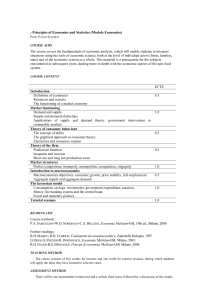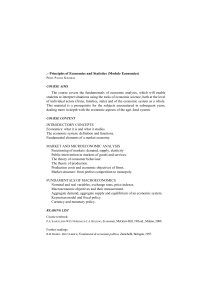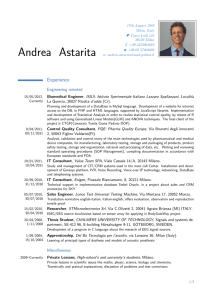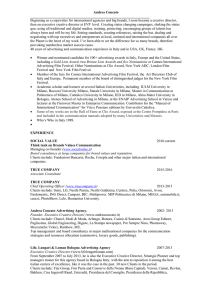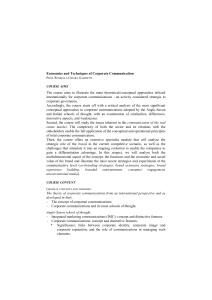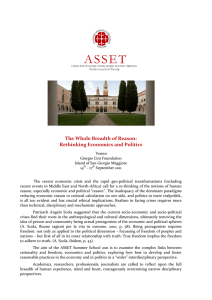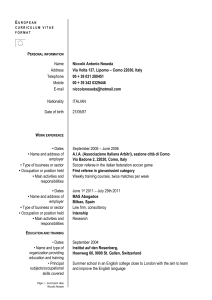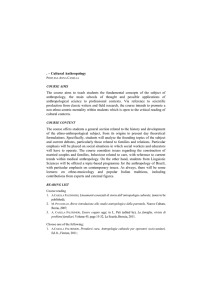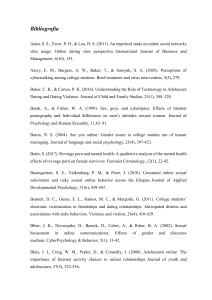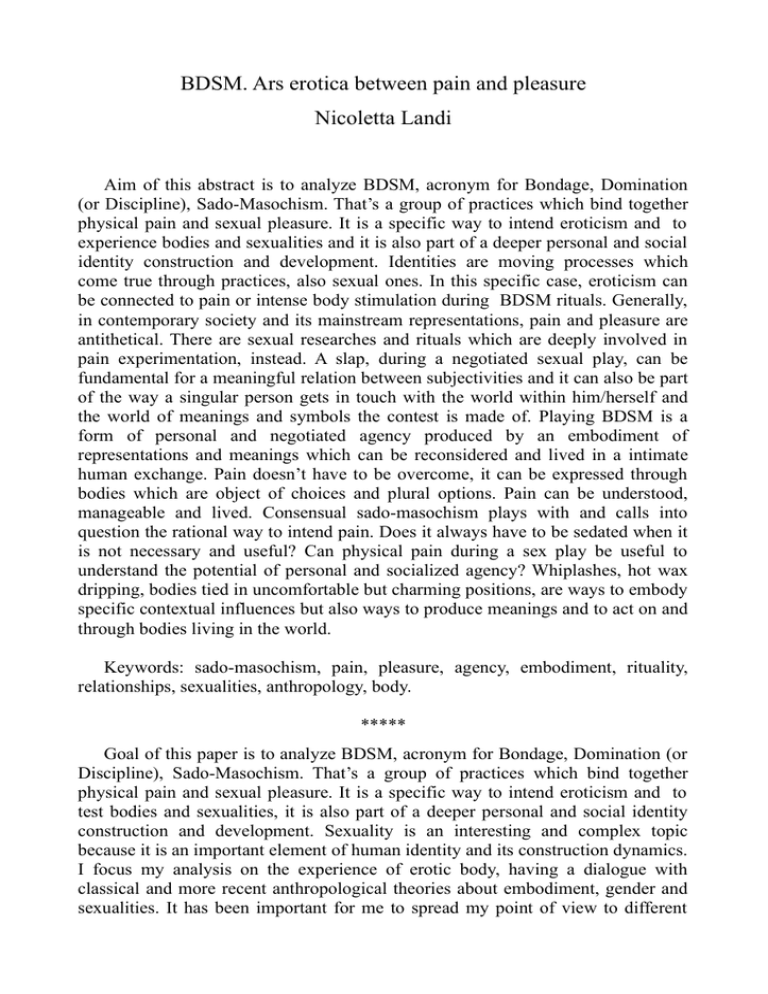
BDSM. Ars erotica between pain and pleasure
Nicoletta Landi
Aim of this abstract is to analyze BDSM, acronym for Bondage, Domination
(or Discipline), Sado-Masochism. That’s a group of practices which bind together
physical pain and sexual pleasure. It is a specific way to intend eroticism and to
experience bodies and sexualities and it is also part of a deeper personal and social
identity construction and development. Identities are moving processes which
come true through practices, also sexual ones. In this specific case, eroticism can
be connected to pain or intense body stimulation during BDSM rituals. Generally,
in contemporary society and its mainstream representations, pain and pleasure are
antithetical. There are sexual researches and rituals which are deeply involved in
pain experimentation, instead. A slap, during a negotiated sexual play, can be
fundamental for a meaningful relation between subjectivities and it can also be part
of the way a singular person gets in touch with the world within him/herself and
the world of meanings and symbols the contest is made of. Playing BDSM is a
form of personal and negotiated agency produced by an embodiment of
representations and meanings which can be reconsidered and lived in a intimate
human exchange. Pain doesn’t have to be overcome, it can be expressed through
bodies which are object of choices and plural options. Pain can be understood,
manageable and lived. Consensual sado-masochism plays with and calls into
question the rational way to intend pain. Does it always have to be sedated when it
is not necessary and useful? Can physical pain during a sex play be useful to
understand the potential of personal and socialized agency? Whiplashes, hot wax
dripping, bodies tied in uncomfortable but charming positions, are ways to embody
specific contextual influences but also ways to produce meanings and to act on and
through bodies living in the world.
Keywords: sado-masochism, pain, pleasure, agency, embodiment, rituality,
relationships, sexualities, anthropology, body.
*****
Goal of this paper is to analyze BDSM, acronym for Bondage, Domination (or
Discipline), Sado-Masochism. That’s a group of practices which bind together
physical pain and sexual pleasure. It is a specific way to intend eroticism and to
test bodies and sexualities, it is also part of a deeper personal and social identity
construction and development. Sexuality is an interesting and complex topic
because it is an important element of human identity and its construction dynamics.
I focus my analysis on the experience of erotic body, having a dialogue with
classical and more recent anthropological theories about embodiment, gender and
sexualities. It has been important for me to spread my point of view to different
humanistic disciplines to understand my object such as Psychology, to be able to
understand the different ways to look at fieldworks and then to produce reality.
BDSM can be considered as a ars erotica, 1 using a Michel Foucault’s definition,
which exists as an embodied process of contextual information but also as a
socialized and intentional practice. Erotizing pain can be a good topic to study how
many the ways of living the body and sexual contacts can be. Every human being
lives in a specific social contest that determinates behaviors, but every person has
the chance to act on him/herself and the others in many different ways, more or
less socially accepted. The acronym BDSM was defined in the United States
during the 80s to define a number of sexual or teasing practices that associate hard
body stimulations and lust. It is useful for those who play this kind of games to
make a difference between sadomasochism as a sexual perversion and consensual
BDSM playing that is always made among consciously involved players. Every
BDSM session has to be SSC (Sane, Safe and Consensual) because it has to be
grounded on reciprocal trust which is necessary to take part to this game. These
ritual sessions reinforce relationships and are useful by the way of being part of
personal identity going through. Ritualizing and playing with social roles, with
power and daily situations helps to exorcise power gaps, death and violence.
Letting these aspects of life be erotic and teasing can be a political critic against
social expectations and also a creative, such as a Michel Foucault’s ars erotica
concept describes, way to intend sex and relationships. Sex can be considered not
only as a natural and naturalized matter as Michel Foucault affirms in his
bio-political studies: sexuality is a knowledge form that can’t be objectified and it
concerns individual and socio-political matters, it is about agency and
transformation of representations and norms. What is expected to be, is lived and
experienced in many different ways which are meaningful as agency and identity
actions. Analyzing sexual pleasure connected to pain is part of a deep analysis of
the fundamentals of individual and social identity constructions. Identities are fluid
processes that flow across bodies which must be always and deeply analyzed by
anthropological researches. Sexuality, such as other aspects of human life, is a
variable characteristic which can be experimented also through physical pain.
There are positive and negative coordinates that define what is right and what is
wrong about human, even sexual, behavior. Sometimes, linking pain to pleasure is
socially considered as a not natural or insane. Contemporary societies, in fact,
consider these two subjects as antithetical. As this research wants to argue, there
are performative and ritualized sexual forms that are deeply focused on seeking
and living physical pain as an erotic matter. Denying of trying to reduce physical
pain, which is very common in Western societies, is just a way to face this
question. There are different agentive practices that express other attitudes to deal
with pain, even connecting it to sexual pleasure. Individual and social agency has
the chance and the power to adapt and change commonly shared points of view
about what has the right to be considered natural or legitimate as an erotic
behavior. Doing BDSM grounds on popular representations about love and the
erotic but it also re-elaborates and plays with this imaginary. Even a slap, just like a
caress, during a consensual sexual meeting can be expression of the relation
between the Self and the Other, between the Self and the World. Listening to who
plays BDSM, the experience of pain is essential. It is the most meaningful aspect
of those who are interested in consensual sadomasochistic relationships. I use the
simple word ‛pain’ to describe, making a linguistic but also a theoretical stretching,
a huge number of practices that provoke the common sense of tolerable physical
experimentation. Studying this challenge is useful to think about body sensing and
its symbolic implications. Analyzing sexualities has to start from focusing on
material culture and especially from the study of the body and the senses as the
place where experience and knowledge converge. Playing with alternative sensory
stimulation is connected with using specific dresscodes, clothes and textiles.
Latex, for example, hides but also exhibits the body just like a second skin making
the body become a erogenous surface and a place where it is possible and exciting
to feel a particular stimulation of the senses. Also high heels shoes induce a
particular physical but also symbolic intention. Willful design is necessary to create
a dynamic and cooperative contact between the people who desire to play with
their bodies during a BDSM ritual. A BDSM ritual is the moment where all the
meanings and implications of this particular erotic intention emerge. Actions are
embodied and codified according to the SSC contract. Everything happens during a
BDSM session is negotiated and a ‛safe word’ can interrupt the play. Rituality is
important to define identities through symbols and performative actions but it is
also part of human expression of construction the self as the metaphoric and
physical place where it gets in touch with the Others and the mystery of eroticism.
Rituals are not simple and mechanical repetitions of codified practices, they are
also culturally defined actions made by people emboding representations who play
and performe them in a creative way. BDSM pain practices are very diversified,
they are often connected to domination and power gap between those who are
taking part to the play. The contact between a Master or a Mistress and a slave is
very deep and elaborate, many of them define BDSM eroticism as different from
‛vanilla sex’ which is sex not including strong physical stimulation, role playing or
power playing. Whiplashes, hot wax dripping, bodies tied in uncomfortable but
charming positions, are ways to embody specific contextual influences but also
ways to produce meanings and to act on and through bodies living in the world.
Pain can be understood, manageable and lived. Consensual sado-masochism plays
with and calls into question the rational way to intend pain. It doesn’t have to be
overcome, it can be expressed through bodies which are object of choices and
plural options. It can even have an erotic appeal. Many performative and ritual acts
are connected to body modification such as body piercing where the bodies are
symbolically and physically marked. During a BDSM session some bodies can be,
provisionally or not, pierced or marked. It depends on what has been negotiated
between those who take part to the play. In this sense, body arises as object of
choices and options inside the process of privatization of it where individuals have
an increasing chance to decide what to do to the bodies they are. This could be
related to a transfer of rights from the public institutions to private ownership
where body modification is not linked to mental illness or abuse. Pathologizing
body modification or the connection between pain and pleasure is part of an
implicit and naturalized compulsion that produces good or bad, right or wrong,
bodies and ways to live them. In this way, creative agency is reduced to simple and
reductive psychological impulse. Sadomasochism clashes often with the law about
what can be considered as an abuse, a physical damage of about what is or what
has to be the limit of such a sexual behavior. BDSMers, anyway, consider to be
very important to decide each time what the limit of the play has to be also to
pretend a kind of normality about the games the love to play. Law is often rigid and
inflexible pretending sexualities to be natural, stable and completely the same for
every subjectivity. It defines the pain measure that can be accepted and tolerated
but it keeps out alternative ways to intend the appeal of pain. It is interesting to
underline that many Governments accept torture but censure the private choice to
link pain and sex. Eroticism has, in this interpretation, to be disconnected from
hard physical stimulation which is considered, for this kind of situation,
unjustified. Giving pain has to be functional to greater goals such as political or
military ones such as in the torture’s case. BDSM plays with these social rules and
contextual conditioning and its considered as not necessary violence is, on the
other hand, fundamental for this sexual preference to exist. Penal codes ground on
and perpetuate human behavior considered unchangeable and regulated by norms
which define what is punishable and what is not. Starting from Michel Foucault’s
studies about sexuality, the law is part of a bio-political control of societies and
human bodies. It produces efficient (sexual) bodies that have to exist between a
number of socially accepted rules that define their right to exist. Nowadays the
debate around human sexual rights is very fertile and useful to discuss the relation
between public institutions and what is considered to be a private space where
individual agency is fundamental and where it can be different from what is
considered to be natural and right. Thinking about universal human rights has to
look into what is lived and performed as a personal, also concerning sexuality,
choice and freedom. Pain has to be considered not only as something which has to
be overcome or functionally quantifiable. It is also part of a greater and deeper
human, sexual and relational, research. Common feeling about pain and suffering
is different in time and space. Pain is not an abstract thought that can or has to be
quantifiable, it is an intentional act where specific factors flow together and come
true. Those factors are variable and many, they concern biological, juridical,
political, historical, cultural concepts and points of view. Very often they are
conflicting and contradictory ones. Rituals such as the sadomasochistic ones let
these contradictions emerge by reinforcing but also playing with those norms that
bio-political power is founded on. BDSMers embody these rules but they
de-structure them in a performative way. Agency means not only to resist against
norms in a dual dimension of repression and resistance. It is a creative way to
inhabit bodies and play with norms, socio-political influences and naturalized
opinions about sexuality and relationships. Pain, for those who play BDSM such as
for ascetics, is not only action but it is passion. Suffering becomes manageable
although pain destroys customs concerning language because it is considered to
break inter-subjective communication. Erotizing pain is a creative and
transforming process giving new sense to reality and human connections. It is a
metaphysical path that biology or psychology simply reduce to something needing
to be sedated or cancelled. Those who are interested in consensual sado-masochism
claim the chance to construct their subjectivities also through shocking practices
and pain-focused rituals. Playing with two antithetical subjects and feelings such as
pain and pleasure means to play and to overcome this dichotomy. Human sexuality
includes unlimited shades, experimenting hard body stimulations or alternative
way of teasing is part of a large number of agency acts. Agency is that bridge that
connects embodied subjectivities and social representations. It overcomes the
supposed opposition between what is right and what is wrong, what is a natural
impulse and what is insane. Putting together suffering and sex means to summarize
this opposition, to embody it and to play with it. Endorphins, even in what
BDSMers say, are important because they explain, in a biological socially accepted
point of view, the contact between pain and excitement. Some other explanations
are useful to normalize this behavior such as remembering ascetic, even catholic,
physical punishments. Doing BDSM is, in fact, a embodied practice but also a
metaphysical process to reach a deep knowledge concerning corporeality, sexuality
and relationship among different subjectivities living in peculiarly influenced and
influencing contexts. Intimacy is transformed into a pure relationship where
pleasure can be experimented through conscious practices and connections, even
testing physical pain. Pain can be understood, manageable and lived. Consensual
sado-masochism plays with and calls into question the rational way to intend pain.
This flexible vision of embodied and creative sexuality is expression of the infinite
mystery of human eroticism.
1 ‛La volontà di sapere’Feltrinelli Milano 2004
Bibliography
AA.VV. ‛Il feticismo della seconda pelle. Antologia di Skin Two’ Shake Milano 1998
G. Agamben ‛Homo sacer. Il potere sovrano e la nuda vita’ Einaudi Torino 1995
J. Alexander ‛Book review: a critical introduction to Queer Theory’ in ‛Sexualities’ 2006; 9; 115
S. Allovio ‛Culture in transito. Trasformazioni, performance e migrazioni nell’Africa sub-sahariana’ Franco Angeli
Milano 2008
D. Altman ‛Visions of Sexual Politics’ in ‛Sexualities’ 2008.; 11; 24
L. M. Augustin ‛New Research Directions: The Cultural Study of Commercial Sex’ in ‛Sexualities’ 2005; 8; 618
Ayzad ‛BDSM. Guida per esploratori dell’erotismo estremo’ Castelvecchi Roma 2004
C. Baldini ‛Corpo ferito: problema della corporeità dall’immaginario al reale’ Tirrenia Stampatori Torino 1991
G. Bateson ‛Naven. Un rituale di travestimento in Nuova Guinea’ Einaudi Torino 1936
A. Beaumont-Vernon ‛Book Review: Unzipping Gender: Sex, Cross-dressing and Culture’ in ‛Sexualities’ 2005; 8;
381
J. Binnie ‛Locating Economics within Sexualities Studies’ in ‛Sexualities’ 2008; 11; 100
P. Bourdieu ‛Per una teoria della pratica. Con tre studi di etnologia cabila’ Cortina Milano 1972
P. Borgna ‛Sociologia del corpo’ Laterza Bari 2005
M. Busoni ‛Genere, sesso, cultura: uno sguardo antropologico’ Carocci Milano 2000
J. Butler ‛Corpi che contano. I limiti discorsivi del sesso’ Feltrinelli Milano 1996
J. Butler ‛La disfatta del genere’ Meltemi Roma 2004
P. Califia “Public sex: the culture of radical sex’ Cleiss Press San Francisco 2000
F. Casale ‛Le perversioni sessuali’ Rialta Milano 1967
S. Chambers ‛Sex and the problem of the body: reconstructing Judith Butler’s theory of sex/gender’ in ‛Body and
Society’ 2007; 13 ; 47
A. Cohen ‛Self consciuosness. An alternative anthropology of identity’ Routledge Londra New York 1994
T. J. Csordas ‛Embodiment as a paradigm for anthropology’ in ‛Ethos. Journal of the Society of Psychological
Anthropology’ vol. 18, n. 1 1990
J. Davison ‛Book review: an emotional history’ in ‛Body and Society’ 2007; 13; 133
G. Deleuze ‛Il freddo e il crudele’ SE Milano 1991
G. Deleuze ‛Il sadismo e il masochismo’ SE Milano 2007
M. Epprecht ‛The Marquis de Sade’s Zimbabwe Adventure: A Contribution to the Critique of “African AIDS” in
‛Sexualities’2007; 10; 243
F. Dei (a cura di) ‛Antropologia della violenza’ Meltemi Roma 2005
F. De Masi ‛La perversione sadomasochista: l’oggetto e le teorie’ Universale Bollati Boringhieri Torino 2007
U. Fabietti ‛L’identità etnica: storia e critica di un concetto equivoco’ NIS Roma 1995.
U. Fabietti ‛Storia dell’antropologia’ Zanichelli Bologna 2001
A. Fausto-Sterling ‛Sexing the body: gender politics and the construction of sexuality’ Basic Books New York 2000
B. Ferrier e S.Levy-Kuentz ‛Sex toys’ Guido Tommasi Milano 2006
J.-L. Flandrin ‛Il sesso e l’Occidente. L’evoluzione del comportamento e degli atteggiamenti’ Arnolodo Mondadori
Editore Milano 1983
M. Foucault ‛Bisogna difendere la società’ Feltrinelli Milano 1998
M. Foucault ‛Storia della follia’ Rizzoli Milano 1963
M. Foucalut ‛Storia della sessualità’ Vol. I ‛La volontà di sapere’- Vol. II ‛L’uso dei piaceri’ Vol. III ‛La cura di sé’
Feltrinelli Milano 2004
U. Galimberti ‛Il corpo’ Feltrinelli Milano 1987
D. Gauntlett ‛Digital Sexualities: A Guide to Internet Resources’ in ‛Sexualities’ 1999; 2; 327
A. Giddens ‛La trasformazione dell’intimità: sessualità, amore ed erotismo nelle società moderne’ Il Mulino Bologna
1995
E. Gregersen ‛Pratiche sessuali’ Lyra Libri Como 1987
D. Haraway ‛Manifesto Cyborg: donne, tecnologie e biopolitiche del corpo’ Feltrinelli Milano 2000
G. Hawkes ‛Sex and pleasure in western culture’ Polity Press Cambridge 2004
J. Weeks e J. Holland ‛Sexual cultures: communities, values and intimacy’ Macmillan Londra 1996
M. Houseman e C. Severi ‛Naven ou le donner à voir. Essai d’interprétation de l’action rituelle ’ Èditions del la Maison
des Sciences de l‘Homme Parigi 1994
A. Kibbey, K. Short e A. Farmanfarmian ‛Sexual artifice: persons, images, politics’ New York University Press Londra
1994
D. Langdridge and T. Butt ‛A Hermeneutic Phenomenoogical Investigation of the Construction of Sadomasochistic
Identity’ in ‛Sexualities’ 2004; 7; 31
T. Laqueur ‛L’identità sessuale dai Greci a Freud’ Laterza Bari 1992
E. Leach ‛A runaway world ? ’ Oxford University Press 1967
A. e H. Lyons ‛Irregular connections: a history of anthropology and sexuality’ University of Nebraska Press 2004
Ruth Mazo Karras ‛Book Review: sex and pleasure in western culture’ in ‛Sexualities’ 2005; 8; 122
M. Lock e N. Scheper-Hughes ‛The mindful body: a prolegomenon to future work in medical anthropology’ American
Anthropological Association 1987
C. Lodedo ‛La costruzione sociale del genere: sessualità tra natura e cultura’ Pensa Multimedia Lecce 2001
C. Madanes ‛Amore, sesso e violenza: strategie per il cambiamento’ Ponte delle Grazie Milano 2000
L. J. Moore and A. E. Clarke ‛The Traffic in Cyberanatomies: Sex / Gender / Sexualities in Local and Global
Formations’ in ‛Body and Society’ 2001; 7; 57
P. Paul ‛Pornopotere. Come l’industria porno sta trasformando la nostra vita’ Orme Editori Milano 2007
L. Pierantoni ‛Rivista di Psicologia’ vol. 30 - n. 1 anno 2006, Dipartimento di Scienze della Formazione Bologna
A. N. Pilgrim ‛Performance and Performative’ in ‛Body and Society’ 2001; 7; 87
V. Pitts ‛Self-Mutilation and Agency in Media Accounts of a Subculture’ in ‛Body and Society’ 1999; 5; 291
G. Pizza ‛Antropologia medica. Saperi, pratiche e politiche del corpo’ Carocci Roma 2005
K. Plummer ‛Studying Sexualities for a Better World? Ten Years of Sexualities’ in ‛Sexualities’ 2008; 11; 7
K. Plummer ‛Visions of Sexualities: Abstract and Introduction’ in ‛Sexualities’ 2008; 11; 23
C. Pussetti ‛Annuario Antropologia. Introduzione. Discorsi sull’amore’ Meltemi Roma 2005 (anno 5, numero 6 )
I. Quaranta (a cura di) ‛Antropologia medica. I testi fondamentali ‘ Raffaello Cortina Editore Milano 2006
T. Reik ‛Il masochismo nell’uomo moderno’ Sugar Milano 1963
F. Remotti ‛Contro l’identità’ Laterza Roma 2001
F. Remotti (a cura di) ‛Forme di umanità’ Mondadori Milano 2002
Reverend William Cooper ‛Sesso estremo: pratiche sessuali senza limiti nell’epoca cyber’ Castelvecchi Roma 1998
R. Reynolds ‛Postmodernizing the Closet’ in ‛Sexualities’ 1999; 2; 346
J. P. Sartre ‛L’essere e il nulla’ Il Saggiatore Milano 1968
E. Scarry ‛La sofferenza del corpo. La distruzione e la costruzione del mondo’ Il Mulino Bologna 1990
S. Seidman, C. Meeks e F. Traschen ‛Beyond the Closet? The Changing Social Meaning of Homosexuality in the
United States’ in ‛Sexualities’ 2 (1) : 9-34
N. Seremetakis (a cura di) ‛The senses still. Perception and memory as material culture in modernity’ Westview Press
Boulder, San Francisco, Oxford 1994
V. Steele ‛Fetish. Moda, sesso e potere’ Meltemi Roma 2005
P. Sweetman ‛Anchoring the (Postmodern) Self? Body Modifiaction, Fashion and Identity’ in ‛Body and Society’ 1999;
5; 51
J.-M. Traimond ‛Dissection du sadomasochisme organisè. Approches anarchistes’ ACL Lyon 2005
T. Wilton ‛Out / Performing Our Selves: Sex, Gender and Cartesian Dualism’ in ‛Sexualities’ 2000; 3; 237
C. Wouters ‛What is Love ?’ in ‛Body and Society’ 2001; 7; 77
A. K. T. Yip ‛Sexuality and the Church“ in ‛Sexualities’ 2003; 6; 60
Nicoletta Landi is a PhD student in ‛Science, cognition, technology and Humanities ’ at Bologna’s University.
Anthropologist and educator, she is interested in sexualities and body’s studies.

